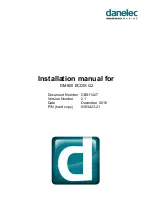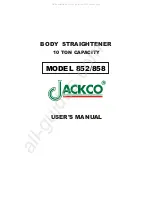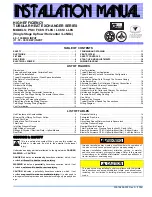
Lake Shore Model 370 AC Resistance Bridge User’s Manual
6.1.4 Status
Registers
There are two status registers: the Status Byte Register described in Paragraph 6.1.4.1, and the Standard Event Status
Register in Paragraph 6.1.4.2.
6.1.4.1
Status Byte Register and Service Request Enable Register
The Status Byte Register contains six bits of information about the operation of the Model 370.
STATUS BYTE REGISTER FORMAT
Bit
–
7 6 5 4 3 2 1 0
Weighting
–
128
64 32 16 8 4 2 1
Bit Name –
Ramp
Done
SRQ ESB Error Alarm Valid
Read
Not
Used
Not
Used
If Service Request is enabled, any of these bits being set will cause the Model 370 to pull the SRQ management line low
to signal the BUS CONTROLLER. These bits are reset to zero upon a serial poll of the Status Byte Register. These
reports can be inhibited by turning their corresponding bits in the Service Request Enable Register to off.
The Service Request Enable Register allows the user to inhibit or enable any of the status reports in the Status Byte
Register. The
Q
SRE command is used to set the bits. If a bit in the Service Request Enable Register is set (1), then that
function is enabled. Refer to the
Q
SRE command discussion.
Ramp Done, Bit (7)
– This bit is set when a ramp is completed.
Service Request (SRQ) Bit (6)
– Determines whether the Model 370 is to report via the SRQ line. If bits 2, 3, 4, 5
and/or 7 are set, then the corresponding bit in the Status Byte Register will be set. The Model 370 will produce a
service request only if bit 6 of the Service Request Enable Register is set. If disabled, the Status Byte Register can still
be read by the BUS CONTROLLER by means of a serial poll (SPE) to examine the status reports, but the BUS
CONTROLLER will not be interrupted by the Service Request. The
Q
STB common command will read the Status
Byte Register but will not clear the bits.
Standard Event Status (ESB), Bit (5)
– When bit 5 is set, it indicates if one of the bits from the Standard Event Status
Register has been set. (Refer to Paragraph 6.1.4.2.)
Error, Bit (4)
– This bit is set when there is an instrument error not related to the bus. The following errors can trigger
this bit to be set: CS OVL, VCM OVL, VDIF OVL, VMIX OVL, R. OVER, R. UNDER, T. OVER, T. UNDER,
Refer to Paragraph 8.6 for a description of error messages.
Alarm, Bit (3)
– This bit is set when there is an alarm condition.
Valid Read, Bit (2)
– This bit is set when each valid reading is taken.
6.1.4.2
Standard Event Status Register and Standard Event Status Enable Register
The Standard Event Status Register reports IEEE bus status of the Model 370.
STANDARD EVENT STATUS REGISTER FORMAT
Bit
–
7 6 5 4 3 2 1 0
Weighting
–
128
64 32 16 8 4 2 1
Bit Name –
PON
Not Used
CME EXE
Not Used
QYE
Not Used
OPC
Bits 1,3, and 6 are not used. The bus controller will only be interrupted with the reports of this register if the bits have
been enabled in the Standard Event Status Enable Register and if bit 5 of the Service Request Enable Register has been
set.
The Standard Event Status Enable Register allows the user to enable any of the Standard Event Status Register reports.
The Standard Event Status Enable command (
Q
ESE) sets the Standard Event Status Enable Register bits. If a bit of this
register is set, then that function is enabled. To set a bit, send the command
Q
ESE with the bit weighting for each bit you
want to be set added together. See the
Q
ESE command discussion for further details.
6-4
Remote Operation
















































